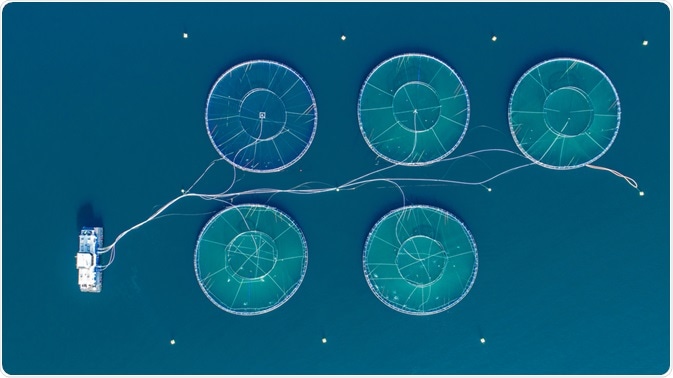Genetics holds a promising role in food sustainability, security, and safety. In the aquaculture industry, genetic information studies have great potential for production efficiency and performance. To accomplish this potential, there is a need for improved genetics and biotechnology tools. Also, the application of these genomic tools would allow the management of key challenges such as the maximization of production with reduced time and cost.

Image Credit: Marius Dobilas/Shutterstock.com
Aquaculture is the culture of aquatic life to fulfill the food demands of human beings. It includes the rearing of fish, mollusks, and crustaceans but the aquaculture industry is facing several challenges. These challenges are diseases, improper growth conditions at fisheries, lack of species-specific food, and novel genomic sources. Due to these factors, the reduction in productivity is a top priority challenge.
However, genetic information (study of genes) can provide useful solutions for these challenges. Through various genetic approaches such as selective breeding, hybridization, molecular markers, productivity in aquaculture can be achieved.
Various genomic approaches with their promising role
The application of genetic studies has enabled researchers to look through the entire genome of any organism. By these studies, the productivity of some aquaculture species has increased with reduced generation intervals. The overall objective of these genetic studies is to increase the production efficiency, quality of the product, sustainability, and achieving maximum profitability for the fish farm holders.
The major aquaculture species are Atlantic salmon, rainbow trout, American catfish, Nile tilapia, and Pacific white shrimp. The genomic selection in these species for various traits (growth, disease resistance, environmental tolerance) can improve sustainable production and profitability. For example, the selection for growth traits in Atlantic salmon, Nile tilapia, and Pacific white shrimp has been achieved with greater efficiencies.
Genetics has proved great potential to achieve 4-5 times higher generations at the commercial level. The growth traits serve as determinants of aquaculture productivity, however, the application of genomic tools for disease resistance traits can establish these species as a global product.
Genome selection
Genetic selection is based on the estimation of the combined effect of many loci across the whole genome. This method predicts the genetic merits of a trait accurately. Genome selection is utilized in rainbow trout against bacterial infections.
In Atlantic salmon, genome selection is applied to study the resistance gene against sea lice. However, its use in aquaculture species is not wide and tailored. On a commercial scale, this method has financial limitations.
Marker-assisted selection
The marker-assisted selection also serves as a genome-based method for the production enhancement of the aquaculture industry. This method has successfully been used for the study of disease resistance genes in various aquatic organisms. For example, the selection of disease resistance genes in Japanese flounder against lymphocytosis.
Another example of the identification of disease resistance gene is in Atlantic salmon. The infectious pancreatic necrosis (IPN) disease—a viral disease presents serious damage to salmon production. Some salmon species are resistant to IPN disease.
Through genome analysis of IPN-resistant and susceptible salmon species, scientists identified a DNA sequence linked to IPN resistance in salmons. Marker-assisted selection has allowed the production of infectious pancreatic necrosis-resistant salmon through the development of genetic marker tests. It even reduces the severe outbreak of IPN disease in the salmon farming industry by up to 70%.
Another major advantage of marker-assisted selection in aquatic farming is the identification of sex using sex markers. The sex-linked markers are used in various aquaculture species such as rainbow trout, white shrimp, catfish, tilapia, and common carp.
The application of the selection markers has allowed the identification and mapping of many markers across the entire genome. As a result, enabling the experts to study the merits of various traits.
Genome editing tools
In aquaculture species, genome editing tools can also be applied to enhance product quality, profitability, and production. These tools induce specific mutations at targeted sites. Such as zinc finger nuclease (ZFN), transcription activator-like effector nucleases (TALEN), and clustered regulatory interspaced short palindromic repeats (CRISPR/Cas9). These novel techniques have an advantage over conventional breeding practices due to their efficiency and great precision.
For example, rapid improvement in the phenotype of aquatic organisms can be achieved in one generation through genome editing techniques. CRISPR/Cas9 system has allowed the study of particular traits in tilapia and catfish. The application Cas9 system has proved great efficiency in tilapia and catfish with a 70-80% mutation rate.
In farmed fish industry, genome editing techniques can improve productivity through the study of particular traits. These traits can be disease resistance, poor egg quality production, etc.
For the performance efficiency of the aquaculture species, there is a need for various research phases. The first phase involves the development of genetic maps and genome sequences, the second phase involves the function understanding of these animal systems. These research developments will contribute to the prediction of the merits of traits for a better phenotype.
Sources:
- Abdelrahman, H., ElHady, M., Alcivar-Warren, A., Allen, S., Al-Tobasei, R., Bao, L., Beck, B., Blackburn, H., Bosworth, B., Buchanan, J. and Chappell, J., 2017. Aquaculture genomics, genetics, and breeding in the United States: current status, challenges, and priorities for future research. BMC genomics, 18(1), pp.1-23. DOI:10.1186/s12864-017-3557-1
- Boudry, P., Allal, F., Aslam, M.L., Bargelloni, L., Bean, T.P., Brard-Fudulea, S., Brieuc, M.S., Calboli, F.C., Gilbey, J., Haffray, P. and Lamy, J.B., 2021. Current status and potential of genomic selection to improve selective breeding in the main aquaculture species of International Council for the Exploration of the Sea (ICES) member countries. Aquaculture Reports, 20, p.100700. DOI:10.1016/j.aqrep.2021.100700
- Zenger, K.R., Khatkar, M.S., Jones, D.B., Khalilisamani, N., Jerry, D.R. and Raadsma, H.W., 2019. Genomic selection in aquaculture: application, limitations, and opportunities with special reference to marine shrimp and pearl oysters. Frontiers in genetics, 9, p.693. DOI:10.3389/fgene.2018.00693
Further Reading